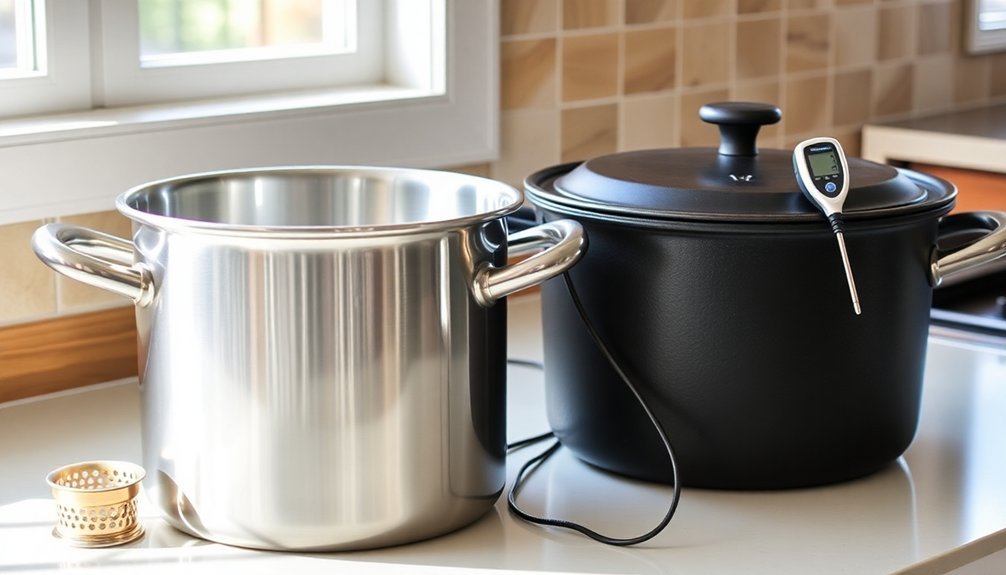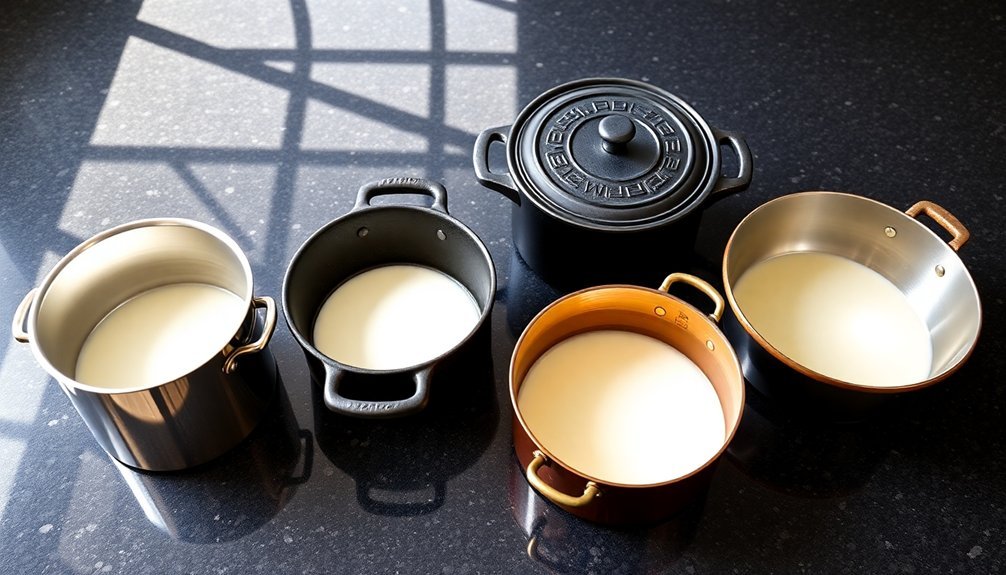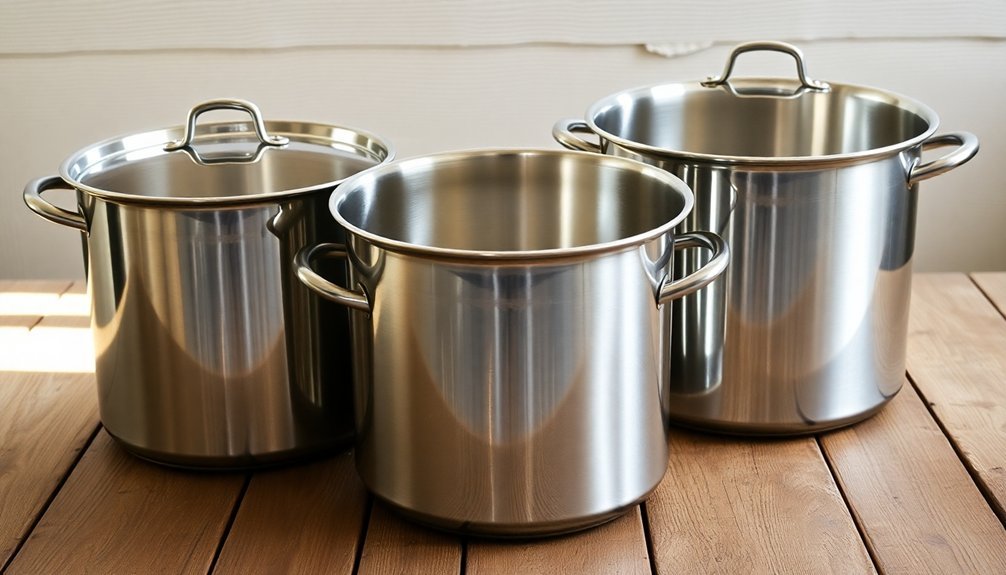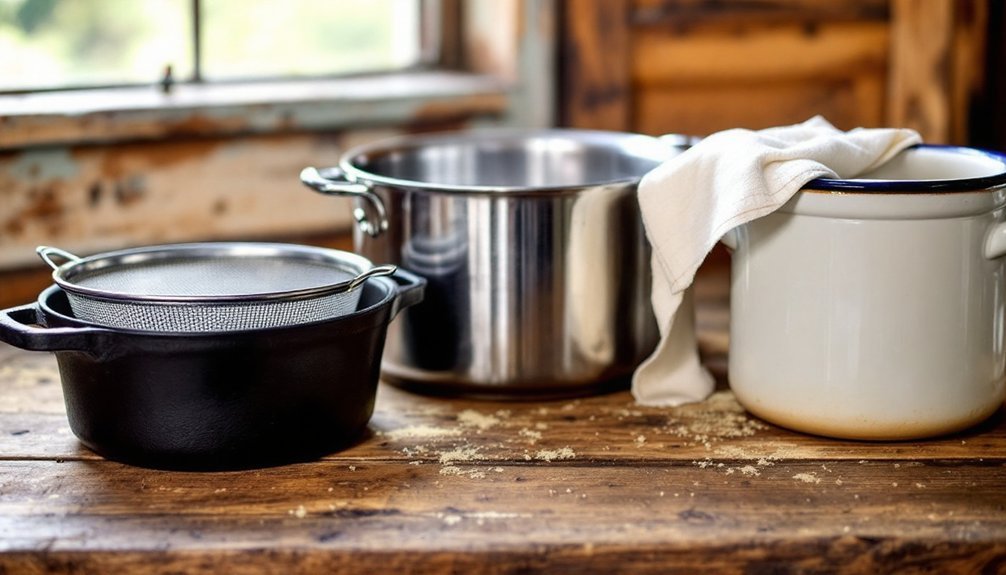For rendering tallow, you'll get the best results with three top vessel options. A heavy-duty enamel-coated Dutch oven offers superior heat distribution and durability for small to medium batches. A large stainless steel stockpot works perfectly for bigger quantities while resisting corrosion. A ceramic slow cooker provides consistent low-heat wet rendering with minimal supervision. Each vessel brings unique advantages that can enhance your tallow-making journey.
Essential Features of Quality Rendering Vessels

When choosing a pot for rendering tallow, the vessel's construction and features play an important role in the success of your rendering process. Quality rendering vessels made from heavy-duty materials like stainless steel provide the durability you'll need for consistent results.
You'll want to select a pot with large capacity and proper heat distribution to prevent warping and guarantee even cooking. A tight-fitting lid is vital to contain odors and moisture, while a sturdy handle lets you safely maneuver the hot vessel.
Look for pots with a pouring spout to help you transfer the rendered tallow without spills. Since hygiene is paramount, choose a vessel that's easy to clean. The rendering process can leave stubborn residue, so selecting a dishwasher-safe pot will make maintenance much simpler and help maintain proper sanitation standards.
Top Pot Materials and Their Performance Benefits

Since the material of your rendering pot directly impacts the quality of your tallow, choosing the right one makes all the difference.
Stainless steel pots offer superior corrosion resistance and evenly distribute heat without reacting with your fat. You'll find enamel-coated cast iron equally effective, thanks to its excellent heat retention and easy-clean surface.
For superior tallow rendering, stainless steel and enamel-coated cast iron provide excellent heat distribution and non-reactive surfaces.
While heavy-duty aluminum pots conduct heat well and are lightweight, they're not your best choice as they may react with the fat. For wet rendering, ceramic or stoneware slow cookers maintain a consistent low temperature, preventing scorching.
Whatever material you select, guarantee you're using a large enough pot to safely accommodate your fat without boiling over. Each material has its strengths, but stainless steel and enamel-coated cast iron consistently deliver the best results for tallow rendering.
Sizing and Capacity Guidelines for Tallow Production

Proper sizing of your rendering pot plays a crucial role in successful tallow production.
You'll need a vessel with at least twice the capacity of your fat volume, as the material expands during heating. For effective processing, match your pot size to your batch requirements.
Here's what you'll need for different batch sizes:
- Small batches (2-3 pounds): A 6-quart stainless steel or cast iron pot
- Medium batches (4-5 pounds): An 8-quart stockpot or Dutch oven
- Large batches (5-10 pounds): A 12-quart stockpot or roaster
- Extra-large batches: Consider multiple pots or commercial equipment
Your chosen vessel should feature a wide opening for easy stirring and water addition.
Select pots with sturdy construction to prevent warping and guarantee even heat distribution.
This careful sizing prevents overflow and guarantees efficient rendering of your tallow.
Frequently Asked Questions
What Is the Best Container to Store Tallow In?
You'll want to store your tallow in airtight glass mason jars or freezer-safe plastic containers. They'll protect against air and moisture, while letting you track freshness. Vacuum-sealed bags work great for long-term storage.
Is It Better to Render Tallow Wet or Dry?
You'll want to use wet rendering for tallow, as it'll give you a cleaner, more purified product with less odor. It's also easier to manage and safer since water prevents burning during the process.
What Is the Best Strainer for Tallow?
You'll want to use a fine mesh strainer lined with cheesecloth for the best tallow filtration. It'll catch all impurities while letting the clean liquid pass through. A colander works too for larger batches.
How Do You Render Beef Tallow in a Pan?
Cut beef fat into small pieces, add 1/4 cup water to a heavy-bottomed pan, and heat on low-medium. Stir occasionally while fat melts for 1-2 hours, then strain through cheesecloth to collect tallow.
In Summary
You'll get the best results from your tallow rendering by choosing the right vessel for your needs. Whether you've selected a heavy-bottomed stainless steel stockpot, enameled Dutch oven, or slow cooker, make sure it meets the key criteria of durable materials, proper heat distribution, and adequate capacity. Make your choice based on your batch size and preferred rendering method for ideal tallow production.





Leave a Reply